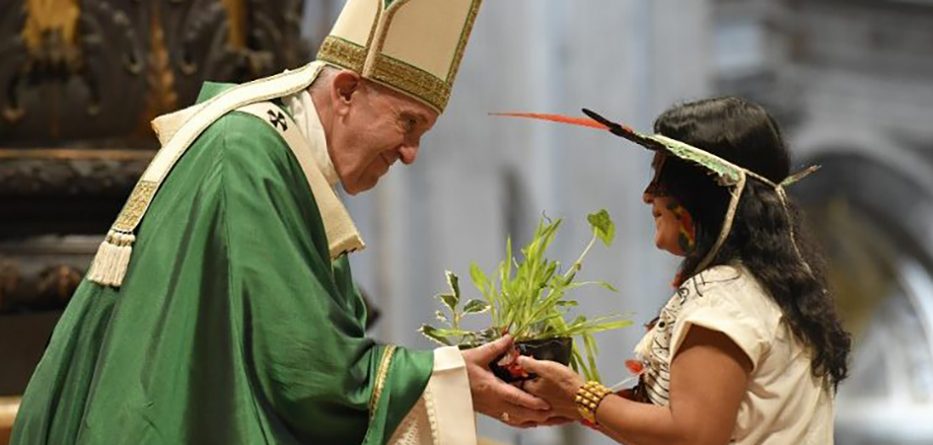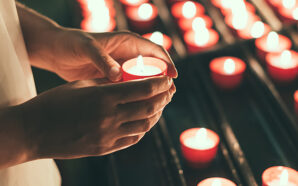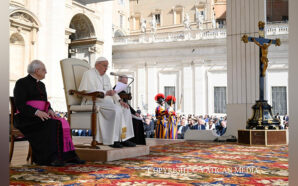Second Sunday in Ordinary Time: Year A: 18 January 2020
In the weeks leading up to the Synod on the Amazon in October last year, there was considerable speculation about two matters in particular:
- Would the Synod recommend to Pope Francis that the rule of priestly celibacy be relaxed for certain isolated regions in the Amazon so that married men of good standing could minister the Eucharist for those isolated communities?
- Would the Synod also recommend that women who were in effect the leaders of Christian communities in some of these isolated regions be recognised as such and, like their male counterparts, be admitted to the Order of the diaconate?
It was during this period, prior to the Synod, that the former Pope, Benedict XVI, wrote an article, probably originally intended for private circulation, in which he spoke strongly against any mitigation of the rule of priestly celibacy, even though he recognised that this might mean that certain Christian communities for a variety of reasons – not just isolation – would be deprived of access to the Eucharist.
This article of the former Pope came to the notice of Cardinal Robert Sarah, a long-time Vatican official, who has become one of the heroes of traditionalist Catholics for his conservative views especially in liturgical matters. He asked Benedict if he might include the article in a book he was preparing for publication in February of this year, entitled From the Depths of our Hearts. Some excerpts of this book have been published in French, and Cardinal Sarah has been interviewed as to its contents.
He shares Benedict’s view that Pope Francis should not permit any mitigation of the rule of priestly celibacy. It would in effect be the ‘thin edge of the wedge’ that would allow the possibility of married clergy in a wide range of contexts – not only in isolated communities but also in cultures where celibacy strongly limits the possibility of otherwise suitable young men embracing a priestly vocation. Some communities in Africa and South America and even our own Aboriginal communities are examples where cultural expectations limit the possibility of vocations to the priesthood.
At the Amazon Synod in October the participants did recommend to Pope Francis by a strong majority (128/41) that the rule of priestly celibacy should be relaxed for certain isolated Amazon communities who would otherwise be deprived of access to the Eucharist. On the possibility of women community leaders being admitted as deacons, the Synod referred the matter to the ongoing papal commission investigating the arguments for and against this “innovation”. I say, “innovation” in brackets, however, because some theologians and church historians maintain that it would not be an innovation, but would merely restore what was a practice in the early Church going back to even Apostolic times.
Pope Francis has yet to publish his Apostolic Exhortation responding to these recommendations of the October Synod, but it is believed to be imminent. Commentators thus see the book by Cardinal Sarah containing the former Pope’s article as a shot across the bows of the current Pope’s imminent Exhortation. It is, they suggest, a blatant attempt to use their joint prestige and theological acumen to inhibit Pope Francis from acceding to the strong recommendation of the participants in the Synod to relax the rule on celibacy and allow married men of good standing to be prepared for ordination.
Now, I have not read Benedict’s article, nor have I read the rest of Cardinal Sarah’s book, but it would appear from the excerpts that have been published and the Cardinal’s interview that their opposition to any mitigation of the rule of clerical celibacy is based on the standard five arguments:
- Jesus himself was not married.
- Clerical celibacy is what is known as an eschatological sign: that is, that the renunciation of marriage on the part of the clergy is a reminder that the customs and practices of this secular world are not necessarily normative – that ultimately it is the world-to-come that matters, that marriage, though legitimate and praiseworthy is not all there is.
- The priestly vocation is incompatible with marriage. One cannot minister simultaneously and effectively to one’s wife and family and to the Christian community. It is too much to ask of a priest to assume such a joint responsibility. One or other, family or community will suffer.
- Even though there is evidence that in the early Church there were married priests, there is also evidence that, once they became ordained, they were prohibited from engaging in sexual relations with their spouses – in effect they became celibate.
- There is a long-standing tradition and ecclesiastical law reaching back universally to the 12th Century and, in many regions and churches, much earlier, that only celibate men should be ordained as priests.
May I comment briefly on each of these in turn?
Firstly, Jesus was certainly not married; but there is, equally certainly, no evidence to suggest that he anticipated that Christian priests would not be married or that it was preferable that they should not be married. Contemporary Jewish priests were married. The first Pope, Peter, we know was married – Jesus healed his mother-in-law. There is a wealth of evidence in St Paul’s Epistles to suggest that presbyters/priests were married (1 Cor 9.4). Even bishops/episkopoi were exhorted to be husbands of one wife. When Paul does speak of the advantages of celibacy/virginity, he commends it as an option rather than mandatory.
Secondly, celibacy can certainly be recommended as an eschatological sign – a renunciation of a legitimate and fulfilling marriage relationship as a sign of one’s commitment to Christ. But it is at least arguable that celibacy can only be interpreted as a sign if it is accepted voluntarily rather than by ecclesiastical law. And it is worth recalling in this other-worldly/eschatological context that, while virginity and celibacy are commended by St Paul, by the early Church fathers and the whole monastic movement, marriage, not celibacy/virginity, is one of seven sacraments that the Church recognises as a special eschatological sign of God’s presence.
Thirdly, on the alleged incompatibility of marriage and priestly ministry, while there is some validity to the argument that marriage will impose extra responsibilities on a priest, there are, equally, benefits and supports that marriage will offer a priest and his ministry. And, of course, there are so many Christian churches, both Eastern churches, Catholic and non-Catholic, where a married priesthood is the norm rather than the exception. As critics of the recent book have been eager to point out, under Pope John Paul II, when Cardinal Ratzinger was Prefect of Congregation of the Faith, married Anglican priests were received into the Catholic Church and, after a period of training, were permitted to minister as Catholic priests. Indeed, under the said Cardinal Ratzinger, as Pope Benedict XVI, in 2009, a Personal Ordinate was established where converts from Anglicanism could worship and celebrate the Eucharist according to modified Anglican rites and be generally ministered by former married Anglican priests.
Fourthly, while there is some historical evidence that in the early centuries where married men were ordained, they were prohibited from subsequently engaging in marital relations, there is also evidence that this was not the universal rule, and that it was honoured more in the breach than in the observance without penalty even when it was the ecclesiastical regulation. I make no comment, of course, on the injustice and insensitivity of imposing such prohibitions on the female member of the marriage contract.
Finally, as to a celibate priesthood being a long-standing ecclesiastical rule, canonists are agreed that it is only since the 12th Century that such a regulation was accepted as a universal law. From apostolic times virginity and celibacy were certainly commended to candidates for the priesthood, but they were commended as voluntary rather than as mandatory. There are instances of married Popes, married bishops, married priests in the Western Church right through the first 12 centuries, and there are currently many Eastern Church Catholic rites where married priests are the norm rather than the exception to this day. Even at the Council of Trent in the mid-16th Century, the question of married priests was debated, and certainly there have been exceptions to the celibacy rule in the Roman rite since the Second Vatican Council.
So, it will be interesting to see whether Pope Francis will accept the strong recommendation of the participants of the Amazon Synod and permit suitably trained married men to be ordained and minister the Eucharist in remote regions of the Amazon forests. I doubt whether he will feel that the debate has been hijacked by Cardinal Sarah’s book. In fact, I suspect, it will probably be disregarded as irrelevant or even harden his resolve. If the Pope does accept the recommendation, it will set a precedent, “the thin edge of the wedge”, as there are many other circumstances, particularly of a cultural nature, where similar claims to mitigating and relaxing the law could be advanced. But each of these should be considered on its merits rather than be subsumed under a universal law of limited historical precedence and limited regional and ritual application.
Fr Bill Uren SJ AO is scholar in residence at Newman College, Parkville.








